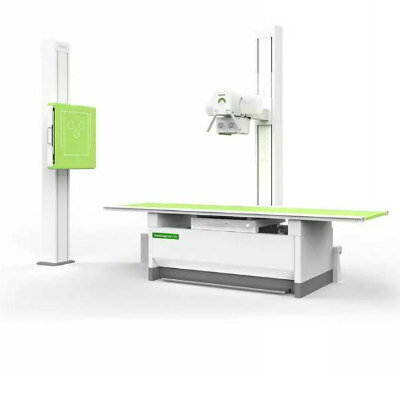LANDAUER and RaySafe Exhibit New Products and Services at RSNA 2019
|
By MedImaging International staff writers Posted on 25 Nov 2019 |

Illustration
LANDAUER (Glenwood, IL, USA) and RaySafe (Billdal, Sweden) showcased several new products and services at the Radiological Society of North America (RSNA) 2019 Annual Meeting held on December 1-5 at McCormick Place in Chicago, USA.
The RSNA Annual Meeting is the world's premier scientific and educational forum in radiology. RSNA 2019, “See Possibilities Together,” offered radiologists from around the world a vast array of education courses, plenary lectures and scientific paper and poster presentations featuring the latest trends, hot topics and cutting-edge research. This year, RSNA featured expanded AI, 3D printing, advanced visualization and hands-on opportunities. The specialty’s leading experts discussed the scientific innovations that are driving improvements in patient care and taking radiology in exciting new directions.
At this year’s RSNA, LANDAUER and RaySafe exhibited several radiation safety and compliance solutions. LANDAUER is a global provider of technical and analytical services to determine occupational, patient and environmental radiation exposure and the leading domestic provider of outsourced medical physics services – both imaging and therapy. RaySafe is a global provider of X-ray quality assurance solutions to help protect patients and staff from unnecessary radiation. Its solutions are designed to minimize the need for user interaction, bringing simplicity and usability to the X-ray room.
LANDAUER showcased LANDAUER OPTIMIZE, a new patient dose optimization solution that combines software and personal guidance from expert, dedicated medical physicists. OPTIMIZE is a cloud-based dose management solution with easy adoption by staff — only requiring about one hour a month to maintain. It features automated monitoring with customized analysis, right patient doses and maximum image quality. Developed by LANDAUER medical physicists, OPTIMIZE allows healthcare providers to focus on caring for patients rather than data — and to serve more patients safely, effectively and compliantly.
RaySafe showcased the RaySafe 452 Radiation Survey Meter, a versatile, powerful tool that can be used for multiple situations, reducing the number of devices technicians need to carry, learn, and calibrate. It is the ideal tool to measure radiation in a wide variety of applications, including finding spilled isotopes, measuring scattered radiation from X-ray machines, and linear accelerators. The RaySafe 452 does not require any corrections or manual settings, letting technicians focus on radiation protection rather than set-up.
RaySafe also featured the RaySafe i3 Real-time Dosimeter System which measures and records radiation every second, providing instant feedback to help interventional radiology staff take steps to learn and adapt their behavior to minimize unnecessary radiation exposure. RaySafe i3 visualizes X-ray exposure in real time using easy-to-read bar graphs to indicate the dose rate for each individual user. The measurements are simultaneously stored for post-procedure analysis, to facilitate continued learning as well as to enable comparisons over time or between labs.
Among other solutions showcased by RaySafe at RSNA 2019 was the RaySafe X2 X-ray QA Test Device, a simple-to-operate test tool that lets technicians focus on the results versus set-up. The RaySafe X2 features a large touch-screen display showing all measured parameters. It does not require any special settings to handle different types of X-ray machines and offers sensors for R/F, MAM, CT, Survey and even light applications.
Related Links:
LANDAUER
RaySafe
The RSNA Annual Meeting is the world's premier scientific and educational forum in radiology. RSNA 2019, “See Possibilities Together,” offered radiologists from around the world a vast array of education courses, plenary lectures and scientific paper and poster presentations featuring the latest trends, hot topics and cutting-edge research. This year, RSNA featured expanded AI, 3D printing, advanced visualization and hands-on opportunities. The specialty’s leading experts discussed the scientific innovations that are driving improvements in patient care and taking radiology in exciting new directions.
At this year’s RSNA, LANDAUER and RaySafe exhibited several radiation safety and compliance solutions. LANDAUER is a global provider of technical and analytical services to determine occupational, patient and environmental radiation exposure and the leading domestic provider of outsourced medical physics services – both imaging and therapy. RaySafe is a global provider of X-ray quality assurance solutions to help protect patients and staff from unnecessary radiation. Its solutions are designed to minimize the need for user interaction, bringing simplicity and usability to the X-ray room.
LANDAUER showcased LANDAUER OPTIMIZE, a new patient dose optimization solution that combines software and personal guidance from expert, dedicated medical physicists. OPTIMIZE is a cloud-based dose management solution with easy adoption by staff — only requiring about one hour a month to maintain. It features automated monitoring with customized analysis, right patient doses and maximum image quality. Developed by LANDAUER medical physicists, OPTIMIZE allows healthcare providers to focus on caring for patients rather than data — and to serve more patients safely, effectively and compliantly.
RaySafe showcased the RaySafe 452 Radiation Survey Meter, a versatile, powerful tool that can be used for multiple situations, reducing the number of devices technicians need to carry, learn, and calibrate. It is the ideal tool to measure radiation in a wide variety of applications, including finding spilled isotopes, measuring scattered radiation from X-ray machines, and linear accelerators. The RaySafe 452 does not require any corrections or manual settings, letting technicians focus on radiation protection rather than set-up.
RaySafe also featured the RaySafe i3 Real-time Dosimeter System which measures and records radiation every second, providing instant feedback to help interventional radiology staff take steps to learn and adapt their behavior to minimize unnecessary radiation exposure. RaySafe i3 visualizes X-ray exposure in real time using easy-to-read bar graphs to indicate the dose rate for each individual user. The measurements are simultaneously stored for post-procedure analysis, to facilitate continued learning as well as to enable comparisons over time or between labs.
Among other solutions showcased by RaySafe at RSNA 2019 was the RaySafe X2 X-ray QA Test Device, a simple-to-operate test tool that lets technicians focus on the results versus set-up. The RaySafe X2 features a large touch-screen display showing all measured parameters. It does not require any special settings to handle different types of X-ray machines and offers sensors for R/F, MAM, CT, Survey and even light applications.
Related Links:
LANDAUER
RaySafe
Latest Industry News News
- Bayer and Google Partner on New AI Product for Radiologists
- Samsung and Bracco Enter Into New Diagnostic Ultrasound Technology Agreement
- IBA Acquires Radcal to Expand Medical Imaging Quality Assurance Offering
- International Societies Suggest Key Considerations for AI Radiology Tools
- Samsung's X-Ray Devices to Be Powered by Lunit AI Solutions for Advanced Chest Screening
- Canon Medical and Olympus Collaborate on Endoscopic Ultrasound Systems
- GE HealthCare Acquires AI Imaging Analysis Company MIM Software
- First Ever International Criteria Lays Foundation for Improved Diagnostic Imaging of Brain Tumors
- RSNA Unveils 10 Most Cited Radiology Studies of 2023
- RSNA 2023 Technical Exhibits to Offer Innovations in AI, 3D Printing and More
- AI Medical Imaging Products to Increase Five-Fold by 2035, Finds Study
- RSNA 2023 Technical Exhibits to Highlight Latest Medical Imaging Innovations
- AI-Powered Technologies to Aid Interpretation of X-Ray and MRI Images for Improved Disease Diagnosis
- Hologic and Bayer Partner to Improve Mammography Imaging
- Global Fixed and Mobile C-Arms Market Driven by Increasing Surgical Procedures
- Global Contrast Enhanced Ultrasound Market Driven by Demand for Early Detection of Chronic Diseases
Channels
Radiography
view channel
Novel Breast Imaging System Proves As Effective As Mammography
Breast cancer remains the most frequently diagnosed cancer among women. It is projected that one in eight women will be diagnosed with breast cancer during her lifetime, and one in 42 women who turn 50... Read more
AI Assistance Improves Breast-Cancer Screening by Reducing False Positives
Radiologists typically detect one case of cancer for every 200 mammograms reviewed. However, these evaluations often result in false positives, leading to unnecessary patient recalls for additional testing,... Read moreMRI
view channel
PET/MRI Improves Diagnostic Accuracy for Prostate Cancer Patients
The Prostate Imaging Reporting and Data System (PI-RADS) is a five-point scale to assess potential prostate cancer in MR images. PI-RADS category 3 which offers an unclear suggestion of clinically significant... Read more
Next Generation MR-Guided Focused Ultrasound Ushers In Future of Incisionless Neurosurgery
Essential tremor, often called familial, idiopathic, or benign tremor, leads to uncontrollable shaking that significantly affects a person’s life. When traditional medications do not alleviate symptoms,... Read more
Two-Part MRI Scan Detects Prostate Cancer More Quickly without Compromising Diagnostic Quality
Prostate cancer ranks as the most prevalent cancer among men. Over the last decade, the introduction of MRI scans has significantly transformed the diagnosis process, marking the most substantial advancement... Read moreUltrasound
view channel
Deep Learning Advances Super-Resolution Ultrasound Imaging
Ultrasound localization microscopy (ULM) is an advanced imaging technique that offers high-resolution visualization of microvascular structures. It employs microbubbles, FDA-approved contrast agents, injected... Read more
Novel Ultrasound-Launched Targeted Nanoparticle Eliminates Biofilm and Bacterial Infection
Biofilms, formed by bacteria aggregating into dense communities for protection against harsh environmental conditions, are a significant contributor to various infectious diseases. Biofilms frequently... Read moreNuclear Medicine
view channel
New SPECT/CT Technique Could Change Imaging Practices and Increase Patient Access
The development of lead-212 (212Pb)-PSMA–based targeted alpha therapy (TAT) is garnering significant interest in treating patients with metastatic castration-resistant prostate cancer. The imaging of 212Pb,... Read moreNew Radiotheranostic System Detects and Treats Ovarian Cancer Noninvasively
Ovarian cancer is the most lethal gynecological cancer, with less than a 30% five-year survival rate for those diagnosed in late stages. Despite surgery and platinum-based chemotherapy being the standard... Read more
AI System Automatically and Reliably Detects Cardiac Amyloidosis Using Scintigraphy Imaging
Cardiac amyloidosis, a condition characterized by the buildup of abnormal protein deposits (amyloids) in the heart muscle, severely affects heart function and can lead to heart failure or death without... Read moreGeneral/Advanced Imaging
view channel
New AI Method Captures Uncertainty in Medical Images
In the field of biomedicine, segmentation is the process of annotating pixels from an important structure in medical images, such as organs or cells. Artificial Intelligence (AI) models are utilized to... Read more.jpg)
CT Coronary Angiography Reduces Need for Invasive Tests to Diagnose Coronary Artery Disease
Coronary artery disease (CAD), one of the leading causes of death worldwide, involves the narrowing of coronary arteries due to atherosclerosis, resulting in insufficient blood flow to the heart muscle.... Read more
Novel Blood Test Could Reduce Need for PET Imaging of Patients with Alzheimer’s
Alzheimer's disease (AD), a condition marked by cognitive decline and the presence of beta-amyloid (Aβ) plaques and neurofibrillary tangles in the brain, poses diagnostic challenges. Amyloid positron emission... Read more.jpg)
CT-Based Deep Learning Algorithm Accurately Differentiates Benign From Malignant Vertebral Fractures
The rise in the aging population is expected to result in a corresponding increase in the prevalence of vertebral fractures which can cause back pain or neurologic compromise, leading to impaired function... Read moreImaging IT
view channel
New Google Cloud Medical Imaging Suite Makes Imaging Healthcare Data More Accessible
Medical imaging is a critical tool used to diagnose patients, and there are billions of medical images scanned globally each year. Imaging data accounts for about 90% of all healthcare data1 and, until... Read more



















